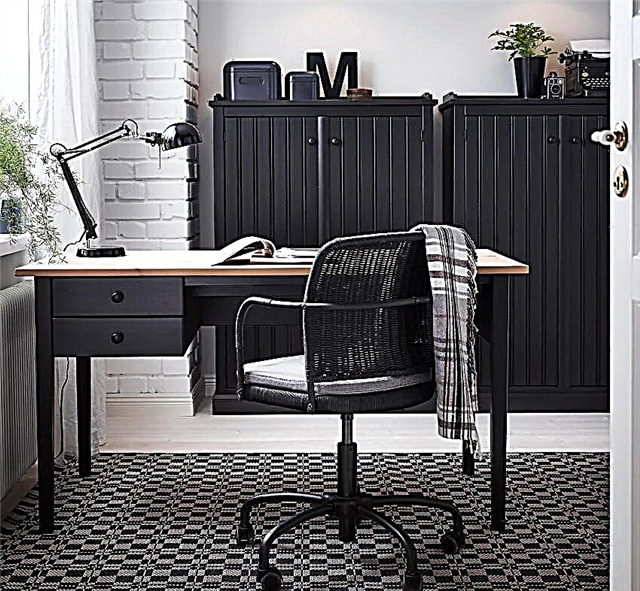Some inexperienced painters ask: "What roller paint the ceiling with water-based paint?". It is quite difficult to give a definite answer, given the pros and cons of a particular tool. Let's find out which roller for painting the ceiling is better, and what factors should be considered when buying.
The coloring composition is considered one of the first important factors affecting the choice of roller. Several types of emulsion paints are on sale: silicone, acrylic, mineral and silicate. Acrylic paints are considered the most popular. They include many acrylic resins and latex. The surface treated with such paint is not exposed to moisture, it is easy to wash, without fear that the appearance of the coating will deteriorate.
Silicone compounds include eponymous resins. They easily cope with small cracks with a depth of not more than 2 mm. Often, such paints are used for coatings that are constantly exposed to moisture. If you dye the wet surface with an emulsion roller, you will be able to get rid of mold and mildew. The only negative is the high cost of silicone paints.

The choice of roller depends on the type of paint
The composition of mineral water-dispersion paints includes a hydroxide form of calcium or cement. They are ideal for painting walls and ceilings, but the life of this composition is much shorter than that of other materials. The main component of silicate compositions is stained glass. Paints of this type are widely used for facade work. They fit perfectly on brick and concrete walls, as well as plaster. Throughout the entire life of the paint reliably saves the surface from bad weather conditions.
As soon as you decide on the type of paint, you will need to choose a roller for painting the ceiling. Many masters use a brush or spray gun to apply the composition. However, as a rule, it is not possible to get a good result from such work. Using a brush, it is quite difficult to get the perfect appearance of the surface, because in any case smudges and clearly visible strokes will appear. A spray bottle is a convenient thing, but not everyone can buy it.
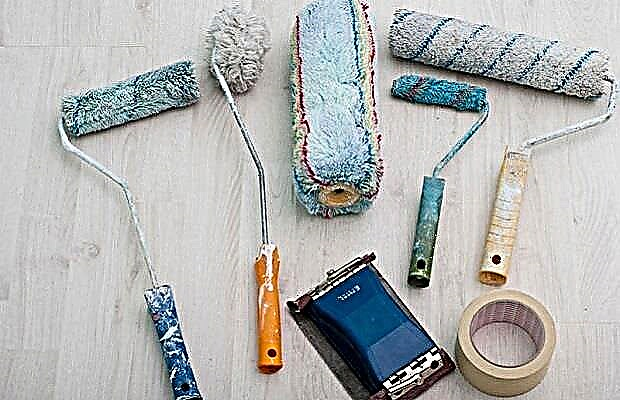
With the roller, everything is much simpler, both in terms of price, so in terms of use and result. Among the wide range of tools on the shelves, rollers made of such materials can be distinguished:
- pile,
- foam rubber
- velours,
- polyamide.
All tools cost about the same. Therefore, inexperienced painters believe that the rollers will not be particularly different during operation. But in practice, this is not so at all. Before you know which roller is better to paint the ceiling, it is worth understanding the properties of each of them. Experience shows that foam tools are ideal for applying glue and varnish. However, they have poorly proven themselves when working with the emulsion. Foam rubber instantly absorbs the coloring composition, and what is not absorbed also quickly flows from the tool to the floor. In addition, foam tools quickly lose their properties and become unsuitable for work.
Pile tools are more versatile. They are widely used for applying various compositions. Manufacturers produce rollers with long, medium and short nap. Specifically for a water-based paint, a good choice would be to buy a tool with medium villi. A short pile cannot absorb enough volume of the composition to work, but a long pile, on the contrary, absorbs too much paint.
When buying a roller for water-based paint, you need to be extremely careful. And first of all it concerns the painting of the ceiling. If you choose a tool with long villi and a large width of the pillow, then it will absorb a large amount of composition and will become very heavy. When working with the ceiling, your hands should always be raised, so you get tired pretty quickly. Given this, we can confidently say that a narrow tool with medium-length villi is suitable for painting the ceiling. Do not forget that during operation, the roller may lose pile and leave it on the work surface. Therefore, it must be removed immediately, otherwise the villi will dry out together with the paint.
A great advantage of velor is its ability to withstand aggressive components of coloring compounds, solvents and varnishes. Rollers made of this material are equally good to use with different coatings. Often, velor rollers are also used for painting ceilings with emulsion. There are no significant drawbacks to such tools. The only negative is the ability to quickly absorb paint, so the roller will have to be regularly lowered into a container with the composition.

Polyamide tools are made from textiles. In this case, the cushion of the roller is stitched with strong threads. Devices of this type are popular among specialists, as they are excellent for applying enamels and varnishes. Polyamide roller is also suitable for acrylic paint. When working, you need to be extremely careful, otherwise the coloring composition can scatter to the sides.
Summing up, we can say that for painting the ceiling it is best to take a roller with a medium pile, as well as a polyamide or velor tool. A device with a velor pillow absorbs a large amount of paint, so working with it can turn into a real torment.
Having decided on the material and properties of the tool, you can go for its acquisition. However, there are several more factors that you should pay attention to already in the store. First of all, carefully inspect the working device. It is very important that the cushion of the roller is the same over the entire length. Threads and villi should not stick out of it in different directions. The handle of the tool must be in perfect condition, without any cracks or other damage. When examining the device, you should not see any seams on the pad. In addition, its surface should be flat along its entire width, without bulges or dips.
To determine the quality of the instrument, it is necessary to squeeze the pad very strongly, hold it a little and release it. She must immediately return to her original size and shape. In addition, you need to check the quality of attachment of the pillows to the axis. To do this, twist it - if during movement you did not notice any backlash, then you can confidently buy such a device. Choosing the right tool for the job is half the battle. You also need to be able to work with him correctly. First of all, the tool pad must be dipped evenly into the paint. Make sure that the composition spreads correctly over the entire surface of the instrument! Try to roll the composition as evenly as possible over the coating. Only in this case, the paint will lie correctly on the ceiling.
Do not roll out the tool pad wherever. As a result, you will leave ugly spray and spoil the surface. Roll out the paint only in the paint tray. So you will not lose the composition and use it to the last drop. If you are starting to paint the ceiling, then do not take for this purpose too large and heavy device. To get a roller of suitable sizes, you need to approximately compare your physical capabilities, the weight of the tool and its productivity, as well as the area of the ceiling. Having done this, you will surely buy a lighter tool with which you can easily paint large enough areas.
Highlights in Ceiling Painting
The first stage of the painting begins with the purchase of paint. It is best to choose water-based dyes for painting ceilings. They are practically odorless, dry quickly, easily applied, immediately improving the appearance of the ceiling surface. Instructions on the can will help you make the right choice of paint, there you will also find information on the method of dilution of the composition. Typically, ordinary water is used as a solvent, which is added to the jar in an amount of about 10% of the total volume.
But most often the emulsion is already sold ready-made, and it can immediately be used for staining.
Advice! For ease of staining, add a small amount of paint to the paint tray. Then splashes will not form, and the paint in the right amount will be typed on the roller.
Water-based paints are produced on an acrylic, silicate, silicone or mineral base. So, for example, the acrylic coating is not completely washed off with water, because it contains glue and latex, which ensures reliable adhesion to the painted surface.
Aqueous emulsion dries much faster than oil paint. And this is an absolute plus. For a bathroom or kitchen, choose silicone-based compounds that tolerate temperature fluctuations and are resistant to mechanical stress.
A detailed report of what paint to use for the ceiling, the best manufacturers and compositions.
Rules for painting the ceiling
The quality of the painting will depend not only on the correct coloring composition, but also on the correct coloring. Experts offer their recommendations, adhering to which, you will get a high-quality and evenly painted ceiling:
- apply paint with at least two coats. In this case, cover the ceiling from the window with a second layer, then small flaws will be invisible,
- when painting do not take breaks, try to paint over the entire surface in one go,
- you can check the uniformity of staining if you look at the ceiling at an oblique angle,
- when there is a buildup of paint on the ceiling, first they need to be rubbed with a washcloth, and then again put a paint coat on these places
- Before wearing the second layer, you need to wait for the first to dry completely.
On a note! If you work with different rollers (on one layer - one tool, on the second - another), the paint will lie more evenly.
Staining is performed as follows:
- use the ceiling roller in one direction only. Apply the paint in the form of the letter “W”, start the next stroke on the previous 2-3 cm.
- apply the second coat of paint perpendicular to the first.
Paint Roller Selection Criteria
Depending on the coating of the paint roller, the rollers are:
- Sheepskin coated
- foam rubber
- plush with nylon
- mohair.
Sheepskin rollers are considered the best quality, but they are not cheap, so not everyone can afford to buy such a tool. Budget counterparts are foam or plush rollers. They can be used not only for painting the ceiling, but also for walls. Moreover, they are suitable for working with almost all compounds.
Mohair rollers are usually used to work with paints containing synthetic resins.
Important! When choosing rollers for painting ceilings, pay attention to the length and diameter of the pile. A wide pile or foam will quickly absorb a large amount of liquid, but the paint layer as a result will be thick and durable.
The right roller selection in terms of convenience
In this case, the main role is played by devices for working at height. It’s good if you have a stepladder or “goats”. Then it’s enough to buy a roller with a handle length of 30-40 cm. If you have to carry out work from a chair or a stool, you will have to look for a tool with a long handle or other devices that allow you to raise the roller to the required height.
Depending on the size, the tools are divided into several types:
- short - up to 30 cm,
- medium - from 35 to 45 cm,
- long - from 50 cm and more.
At the same time, the rollers on which the fleecy coating is worn are equipped with adapters of plastic or metal, and inside they are made hollow, so that it is convenient to fit them on any handle length.
On the modern market of building materials for sale, you can find handles of different sizes, the length of which starts from 70 cm, and the telescopic base allows you to extend it even up to 4 meters. Unfortunately, not every roller can be equipped with a long retractable handle, so you need to choose the right option in advance.
How to determine which roller is best for painting the ceiling
There are many materials used for the manufacture of rollers. In order not to get confused in this variety and choose the right option, they are conditionally divided into four groups:
- foam rubber, faux fur,
- coatings from natural materials,
- polyacrylic
- polyamide rollers.
Not every roller can be applied one or another composition. If you think with what rollers to paint the ceilings with water-based paints, the seller in the store will advise you to buy foam nozzles.
If you use a paint that contains synthetic resins, select a mohair or fur roller. It is better to apply varnish on the ceiling with thin small nozzles, and for water emulsions use wide and thick rollers.
If you talk about which rollers for painting ceilings will be the best, then experts advise choosing tools with fur nozzles, namely from expensive sheepskin. A universal option is foam rubber, which for lack of a better alternative will successfully cope with the functions assigned to it. It can be used to work with acrylic paint, oil or water emulsion. Nylon is also considered popular, which is well suited for applying paints and varnishes.
Design of rollers for painting ceilings
Rollers, depending on the type of construction, are clasp and two-arm.
The clasp is made in the form of a curved rod made of metal. The nozzle is attached to the clasp using a stud or a special coupling.
The two-armed appearance resembles a kind of fork that holds the nozzle in the form of a movable cylinder on both sides. Clasp rollers are more common, they are more convenient to use.
The sizes of the clasp, as well as nozzles are different. You can find on sale very small rollers (4-5 cm) or large (up to 40 cm and above). The wider the nozzle, the larger the surface at one time covered by a roller. Also, when choosing, pay attention to the diameter of the drum. The larger it is, the slower the rotation of the roller occurs, and, accordingly, less spatter is formed during the staining process.
The design of the fasteners is also of no small importance. It is of three types:
- coupling integrated in the nozzle. It is usually used for narrow clasps, the thickness of which does not exceed 6-8 mm,
- the drum locks directly to the handle. After staining, such a roller has to be thrown away,
- frame clasp. A cover that does not have a bearing center is pulled onto its frame.
The most convenient tool for painting the ceiling is the first type of tool - a coupling roller.
There are rollers with the supply of paint during the work, which are equipped with manual air injection mechanisms and special tanks.
Conclusion
Thus, in order to choose a good quality tool when buying, pay attention to:
- convenience when painting,
- nozzle material
- pile length
- design features.
Before buying, be sure to study the information of each type, compare their characteristics. Then you will certainly succeed in achieving the desired result in practice.
The choice of tool depending on the type of emulsion
When purchasing a paint roller, you must first determine which coloring composition will be used. In building stores you can find the following types of tools:
- Fur They are most popular due to the excellent structure. Their use allows you to save consumables, as the fur transfers the emulsion to the surface in full. The coating is uniform, sometimes one layer is enough to get an excellent result.
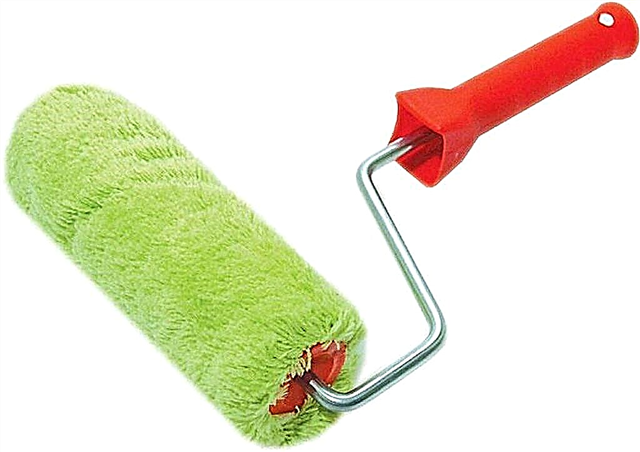
- Velor Suitable for water based paint. Withstand the action of solvents, serve for a long time. The cons include a large consumption of material, since velor absorbs emulsion well. For surface finishing with relief and bumps is not suitable.
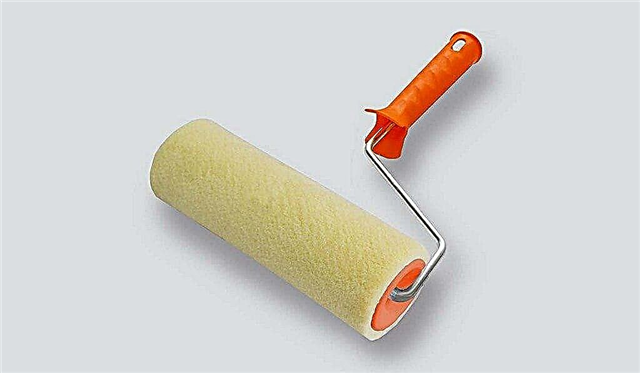
- Foam rubber. This type is often used in practice, due to the low price. The material perfectly absorbs the paint, but with further work it flows off the roller. For surface treatment with significant flaws is not suitable.
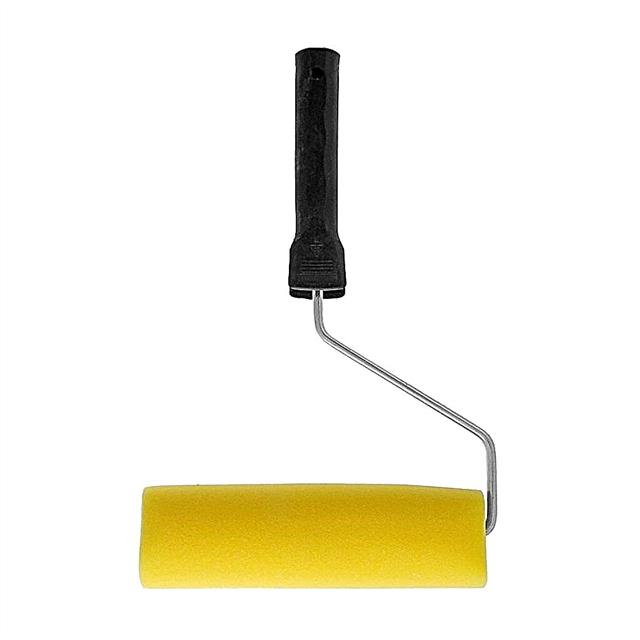
- Thread. High-quality, durable material. But it’s difficult to work on large areas, since the paint splashes and flows.
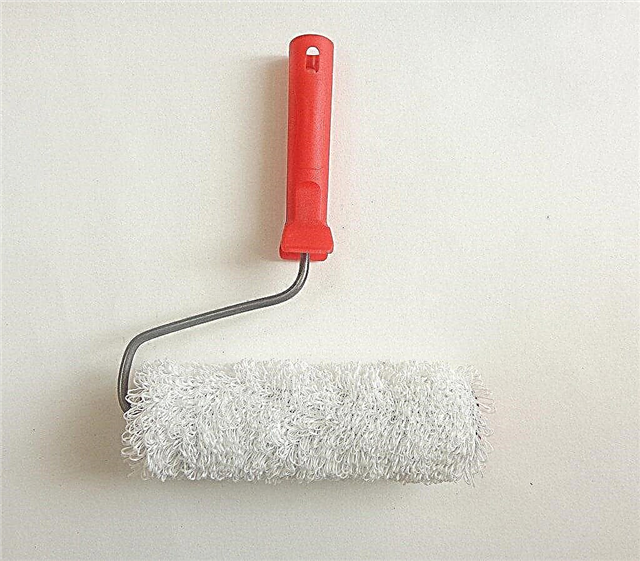
Having correctly decided on the roller, it will be easy to paint the ceiling with water-based paint.
Velor and pile tools: pros and cons
Tools with a pile are considered universal. Modern manufacturers offer a choice of rollers with pile of different lengths, from 10 to 30 cm - standard sizes. To paint the ceiling with water-based paint, you need to know the features of working with various types of improvised materials.
Pillows with a short pile are not able to absorb the emulsion in sufficient quantities, and a long one captures too much volume. Therefore, when working with this finishing material, the product with an average pile length will be the best choice.
With a velor roller, you can paint the ceiling with a water-based paint. The only drawback is that it quickly absorbs paint, and you will often have to dip it into the emulsion.
Important! When working with a large, wide pillow, when painting the ceiling, your hands will quickly get tired, so it is better to choose a medium-sized pillow. A wide, long pile roller is a great choice for working on uneven surfaces.
Roller selection in shape and size
Rollers are available in three sizes:
- Small - up to 10 cm wide,
- Medium - 10-20 cm wide,
- Large - from 30 cm wide.
The most convenient to use tools of medium width. Large rollers are used on large surfaces. When working with high ceilings, semicircular cone-shaped products can be used.
Depending on the length of the handle, the rollers can be classified into long, medium and short. Handles longer than 50 cm are considered long. For convenience, the presence of stepladders or other devices that allow you to work with high surfaces is taken into account.

For your information! When working with nap rollers, care must be taken so that the hairs do not remain on the surface, this will spoil the result, making the appearance not aesthetic.
Nozzles can be interchangeable, most often this is equipment made from natural fur. The diameter of the nozzle also plays a role; the wide one rotates more slowly. The paint sprays less and the surface is flat.
Cushion Shopping Tricks
Choosing a roller for painting the ceiling is not easy. Having decided on the material of the pillow, its width, the size of the handle, you can go for a purchase. The following should be considered:
- The villi should be evenly spaced along the entire length,
- No seams should be visible on the surface of the pillow,
- After compression, the surface should recover quickly,
- The handle of the tool should be flat and smooth.
The final choice of a tool for applying a water emulsion on the ceiling surface depends not only on its properties, but also on the type of paint, the area of the surface to be painted, and the base material.
Key selection criteria
The painting tool is selected, depending on the coloring composition used, the ceiling area and the height of the processed base. To choose a roller, the structure of the surface to be painted is of great importance - plastered cement, brick, building blocks with putty, previously painted ceiling or drywall. What to consider when choosing a roller for the ceiling:
- Type of paint. Ceilings are finished with coloring compounds for interior work. These include water emulsion (or water dispersion), alkyd, latex, oil, silicone, mineral, silicate, polyurethane paint, as well as acrylic compositions. All of them differ in component filling, absorption, material consumption per square meter, consistency and adhesive properties.
- Type of the processed surface. To align the base of the ceiling, plasterboard is often used in repairs. It can be painted with any paint. Plastered surfaces absorb paint well, here you need to consider paint consumption. Wooden ceilings in modern living quarters are rare (houses, cottages, summer cottages) - oil is mainly used for painting wood surfaces.
- The height of the ceiling base. High-quality, uniform, holistic staining is possible only with the convenience of painting work. If the room has a high ceiling, you need to choose a tool with a long handle, for example, painting with a stepladder with a roller is not very convenient and the speed will be lower. For a multi-level ceiling structure, a roller and a brush are used to paint hard-to-reach spots, joints.

The painting tool differs in size, diameter of the drum, coat, length of the handle, curvature of the clasp (handle). These nuances must be taken into account, since it is more convenient to work at heights with a device with a long handle, it is faster to paint a large surface with a wide roller, equipment with a small drum size is easier to paint - the master does not get tired. The right choice of roller for finishing ceilings provides high quality painted surface.
Product Design Features
The roller for painting the ceiling consists of several main parts: a drum (tube or rod), a clasp (handle or handle) of curved shape, removable upholstery (fur coat) made of natural or synthetic material. In the process of painting, the roller rotates freely on the rod, ensuring uniformity of application of the coloring composition. By size, the rollers are conditionally classified into several groups:
- From 50 to 100 mm - mini-rollers that are convenient to use for finishing complex sections of ceilings from two, three or more levels. Joints, corners are painted over with a paint brush.

- From 100 to 250 mm - midi-rollers used in the processing of medium-sized ceilings. Products are easy to use, quickly and evenly distribute paint on the ceiling.
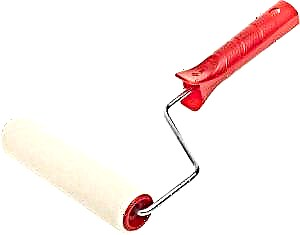
- From 250 to 400 mm - maxi-rollers, mainly used in the decoration of overall ceilings. Rarely used in residential premises, suitable for processing shops, warehouses, trading floors.

The length of the roller handle must be proportional to the size of the drum. A common option is a clasp from 150 to 500 mm. When painting a ceiling of a large area, it is recommended to use rollers with a drum diameter within 300-350 mm, in high rooms, paint is done with devices with an extended handle, and for painting simple ceilings in a small room, a roller of 100-150 mm in size is enough.
In addition to rollers with replaceable fur coats on the plugs, glued and thermo-glued devices are distinguished, on which the upholstery does not change, but is firmly fixed to the cylindrical rod.
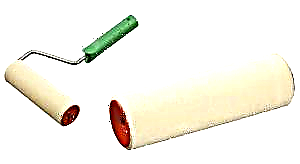
On the video: what should be the paint roller.
Types and upholstery material
The main task of the master when choosing a tool for finishing ceilings is to achieve uniform application of paint without drips, unpainted areas, sag and drops. What roller paint the ceiling? This largely depends on the type of base on which the coloring substances are used. In the manufacture of the working tool, the upholstery (fur coat) is made of natural and synthetic materials. Consider the features and advantages of the upholstery of the roller for painting:
- Natural basis (soft sheepskin, other fur). Ideal for machining complex ceiling structures. Any type of paint holds well on the sheepskin, the composition can be applied with a minimum flow rate. In addition, a natural roller is better than synthetic in technical characteristics, it is better to use it when painting with water-dispersion, oil or acrylic paint due to the uniform distribution of the composition on the ceiling.
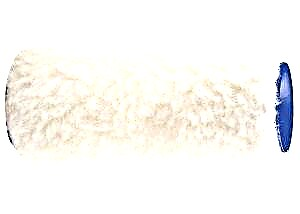
- Foam fur coats made of synthetic material. Differ in ease, high porosity, fast absorption. It can not be used for acrylic paint and water-based compositions, since bubbles form on the surface, and the coloring matter flows down the handle. Foam roller is suitable for painting reliefs, for example, gypsum stucco. Such a tool is needed when decorating ceilings with oil compositions.

- Fur coat made of polyamide synthetics. The main advantage of the upholstery material is its excellent retention of colors, the integrity and uniformity of the applied coating. Polyamide prevents paint from flowing down the roller handle when working under high ceilings. It is convenient to paint the ceiling with acrylic paint using a tool with polyamide upholstery, and water-dispersion compositions of any consistency and viscosity can be applied.
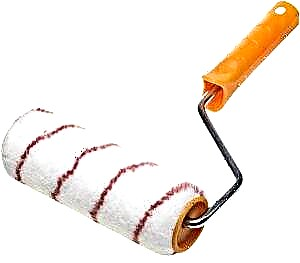
- Synthetic polyacrylic material. Acrylic roller looks like an instrument with upholstery made of natural wool, a good tool for working with different colors. The product has excellent performance, affordability. Polyacrylic coat is used for applying water-dispersion, latex and acrylic paints.
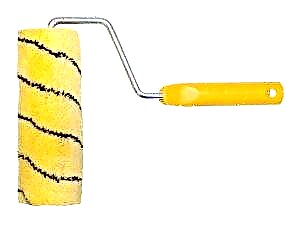
- Rollers with polyester upholstery. The material absorbs the coloring matter well, does not allow dripping of paint on the handle of the paint tool. The advantage of polyester is that there are no stains on the painted surface. Rollers with polyester upholstery are used when working with water-based and acrylic compositions, can be used for applying latex paints. Lack of material - short service life.

- Upholstery made of polyamide or polyacrylic yarns. Most often these are long-nap rollers. The device is used for applying chaotic patterns on the ceiling. It is necessary to work with thread rollers slowly and carefully so that when scrolling the drum splashes of water-based emulsion, acrylic or latex paint do not fly. A threading tool is considered the best when working with porous, textured surfaces.

Painting with synthetic resin-based compounds takes place using terry rollers - devices leave a neat and even coating on the selected surface. Manufacturers of paint tools produce velor rollers, after using which the surface looks absolutely smooth. Velor rollers can also be varnished.
For applying volumetric patterns on the ceiling, rollers with a static (non-removable) polymer coating are used. A relief pattern is made on the surface of the drum, which is repeated on the ceiling during the painting process.

Which roller to choose for whitewashing the ceiling?
Environmentally friendly material for the ceiling - chalk or lime for whitewashing. The composition is selected, depending on what means the whitening was previously performed - chalk is applied to chalk, lime is coated on the surface treated with lime. Do the work with a brush for a long time, and when using a spray gun, you can spray the walls and floor. Therefore, it is convenient to use rollers with foam upholstery.
Advantages of whitewashing with a foam roll:
- perfectly smooth surface without streaks, spots and sagging whitened,
- fast whitewashing of the ceiling due to the size of the foam rollers,
- obtaining a coating having moisture protective properties,
- concealment of minor flaws, good adhesion of white with a base,
- economical consumption of whitewash material - lime or chalk.

Whitewashing with a roller is carried out in two layers, and each white strip applied to the ceiling should capture part of the previous one. Ceiling decoration begins along the wall with the window. The roller is dipped in a tray with white, slightly squeezed and whitened with neat reciprocating movements. Using a foam roller for whitewashing the ceiling allows you to get a uniform hollow coating.
The device must be equipped with a long handle so that the ceiling can be whitened with a foam tool without a stepladder, chair or table.

Additional recommendations
Which roller is better to paint the ceiling? The choice of tool depends on the specific operating conditions - the type of base, type of paint, ceiling height and room size. However, whatever the painting tool was chosen, before painting, it is mandatory to carry out preparatory work:
- Remove the old coating (wallpaper, paint, whitewash).
- Seal cracks, joints and chips with putty.
- Apply a primer to ensure good adhesion.
- Prepare a working composition, a paint tool.
- Paint roller can be applied in one or more layers.
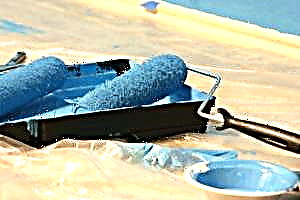
Important! When working with a paint brush, stains and unpainted areas may remain on the ceiling, so you will have to paint the ceiling two or more times. Use rollers, this saves paint and your time.

How to correctly choose the inventory? The main thing to evaluate the quality of the tool is the strength of the handle, the ease of replacing the drum nozzle, the softness and density of the pile. To understand which roller to choose in size, keep in mind that the tool will become heavier when dipped in paint. In addition, you need to check that the villi do not fall out of the upholstery, otherwise they will remain on the ceiling.
How the type of paint affects the choice of roller
To select a working tool, you need to focus on the type of dye used:
- When whitewashing the ceiling, foam-coated rollers are used. They absorb and retain thick solutions that have the consistency of sour cream. Such drums are also recommended for painting stucco made of gypsum.
- Rollers with a polyester coating are suitable for working with acrylic or water-based paint. This material absorbs and retains the coloring composition well. The surface treated with such a drum does not have streaks and stripes; it is monophonic over the entire area.
- Polyamide and polyacrylic rollers feel like fur to the touch. They are used to apply water-based dyes to the ceiling.
- If it is necessary to obtain a surface with patterns, it is better to use a drum with a thread pile, which consists of long polyamide or polyacrylic fibers. It is designed for any paints, but when working with liquid aqueous solutions, the threads spray them, and so that many drops do not form, the color should be done slowly.
- Velor and fur drums are easily applied to the ceiling with paints made on an organic basis (latex, acrylic, water-dispersed or water-based mixture). Such rollers absorb these compounds well and then evenly lay on the work surface.

For processing the ceiling, it is recommended to use rollers with a natural coating. On them, the paint is distributed more evenly than on drums with artificial materials. Foam, polyamide, polyester coatings leave more stripes on the ceiling surface than a tool with fur.
When choosing a roller, it should be noted that the thicker the paint used, the shorter the pile should be on the tool.
Pile or foam - which is better in practice
When choosing a roller for water-based paint, the following should be considered:
- with a pile tool, water-based dyes are easily applied to the ceiling from any material,
- Foam rubber will not work with a water-based composition, since the paint will quickly absorb into it and, when pressed on the roller, will immediately pour out.
When painting the ceiling, use drums covered with fur.

They have the following advantages:
- allow to process any difficult surfaces,
- hold any colors well
- provide high quality coverage,
- have a long service life.
The only drawback of such rollers is their higher price compared to drums made of artificial materials.
Polyamide or velor tools - where to apply
Rollers covered with polyamide are well suited to paint the wallpaper on the ceiling - in the interior of modern apartments such design decisions are often found. But to work with such an instrument, you must have the appropriate skill, therefore, such drums are used by professionals.
Polyamide coats have the following advantages:
- completely absorb and hold the dye,
- the mixture does not drip onto the handle and does not drip,
- it turns out uniform coloring of the ceiling.

Such a roller is used for painting ceiling coatings of any material.
It is recommended to use tools with a velor coating for applying water-based emulsion dyes on a concrete ceiling.
Buying a roller and tricks when using it
When choosing a tool, it is recommended to pay attention to the following factors:
- the pile should be firmly fixed to the drum,
- the handle should be comfortable
- after squeezing the fur coat with fingers, its structural layer should recover quickly,
- no seam should be felt on the drum, otherwise after painting on the ceiling there will be traces in the form of stripes.
When choosing a tool, it is necessary to take into account the fact that if it is not possible to use a stepladder, it is better to purchase a roller with a long handle. For most drums, the size of the handle varies from 15 to 50 cm. For convenience, it is advisable to choose a tool with a handle from 30 to 50 cm long. Some manufacturers produce a tool that can change the length of the handle.
It is recommended to choose a roller depending on the coating profile. If it is necessary to process the surface in the corners of the ceiling, then the length of the handle should be in the range of 20-30 cm. If there are large, even areas, this parameter should be selected in the range of 30 to 40 cm.

The use of the roller for self-painting of the ceiling with acrylic or an aqueous emulsion mixture occurs as follows:
- First assess the surface condition. If there is old paint on the ceiling, then it must be removed with a scraper or wash. If this is whitewash, then vinegar solution of 3% is used to remove it. After that, the entire surface is washed with clean water, and then wait for it to dry.
- After this, the ceiling must be primed. If places affected by fungi or mold appear on it, then the primer should contain an antiseptic.
After this, it is necessary to prepare large and small rollers, a paint tray, a small plastic vessel, 2 brushes (narrow and wide), rags.
The paint is diluted to the desired consistency in accordance with the instructions, pour it into the vessel and tray.
If skirting boards or sockets are located under the ceiling, then painting begins with them. Do this with a narrow brush before starting the main job. Then dip the roller in the paint, roll it on the tray. Ceiling treatment starts from the corner and then covers the entire surface with the mixture. Carefully remove paint stains.
It is recommended to move the tool smoothly so that the solution does not spray. It is necessary to paint with squares, so that they overlap each other a little.
After finishing the ceiling, it is recommended to wait 4 hours for the first coat of paint to dry. After that, they continue to work, applying strokes perpendicular to the original direction.
The quality of the dye depends on how many times it will need to be applied to the surface to be treated. Most often, 2-3 layers are enough for painting the ceiling, the latter should be parallel to the light from the window opening.
You can choose a roller yourself, taking into account all of the above requirements. In order that the tool does not deteriorate after the first painting, it is recommended to put it in an appropriate solvent (water, etc.).







